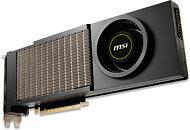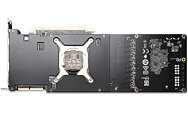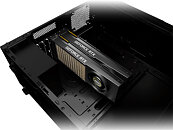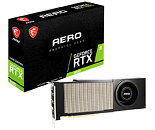- Joined
- Oct 9, 2007
- Messages
- 47,297 (7.53/day)
- Location
- Hyderabad, India
| System Name | RBMK-1000 |
|---|---|
| Processor | AMD Ryzen 7 5700G |
| Motherboard | ASUS ROG Strix B450-E Gaming |
| Cooling | DeepCool Gammax L240 V2 |
| Memory | 2x 8GB G.Skill Sniper X |
| Video Card(s) | Palit GeForce RTX 2080 SUPER GameRock |
| Storage | Western Digital Black NVMe 512GB |
| Display(s) | BenQ 1440p 60 Hz 27-inch |
| Case | Corsair Carbide 100R |
| Audio Device(s) | ASUS SupremeFX S1220A |
| Power Supply | Cooler Master MWE Gold 650W |
| Mouse | ASUS ROG Strix Impact |
| Keyboard | Gamdias Hermes E2 |
| Software | Windows 11 Pro |
MSI today unveiled the GeForce RTX 3090 AERO, the latest in the crop of RTX 3080 and RTX 3090 graphics cards with rear-venting lateral airflow coolers, such as the ASUS RTX 3090 Turbo OC and the GIGABYTE RTX 3090 Turbo, targeting environments with restricted airflow (such as rendering farms). The MSI RTX 3090 AERO strongly resembles the reference-design of NVIDIA's GeForce GTX 480 "Fermi."
The card's blower guides air-flow laterally through an aluminium fin-channel heatsink that isn't hidden underneath a cooler shroud, but rather extends all the way out to the thickness of the card, with its top-plate having some finnage of its own. Much like the ASUS card, the MSI AERO uses two 8-pin PCIe power connectors that are located its tail-end, rather than at the top. Only half of the card's reverse side is covered by a back-plate, meant to cool the memory chips located there. The other half is bare PCB. This has been done to make it easier for an adjacent card to breathe. The card otherwise sticks to NVIDIA-reference clock-speeds for the RTX 3090. The company didn't reveal pricing.





View at TechPowerUp Main Site
The card's blower guides air-flow laterally through an aluminium fin-channel heatsink that isn't hidden underneath a cooler shroud, but rather extends all the way out to the thickness of the card, with its top-plate having some finnage of its own. Much like the ASUS card, the MSI AERO uses two 8-pin PCIe power connectors that are located its tail-end, rather than at the top. Only half of the card's reverse side is covered by a back-plate, meant to cool the memory chips located there. The other half is bare PCB. This has been done to make it easier for an adjacent card to breathe. The card otherwise sticks to NVIDIA-reference clock-speeds for the RTX 3090. The company didn't reveal pricing.





View at TechPowerUp Main Site




